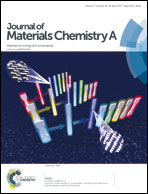Porous activated graphene nanoplatelets incorporated in TiO2 photoanodes for high-efficiency dye-sensitized solar cells
Abstract
Activated graphene nanoplatelets (a-GNPs) were first prepared by a hydrothermal method with KOH as the activating agent. The effects of the preparation conditions on the morphology and structure of the a-GNPs were studied in detail. Morphological observations and N2 adsorption–desorption isotherms indicate that the a-GNPs exhibit a uniform pore size distribution and have a larger specific surface area (113.5 m2 g−1) compared to graphene nanoplatelets (GNPs). The incorporation of a-GNPs (0.02 wt%) into a TiO2 film photoanode in a dye-sensitized solar cell (DSSC) enhances the short circuit current and energy conversion of the cell by 35.8% and 26.8%, respectively. The TiO2/a-GNP composite photoanodes were characterized by UV-vis spectroscopy and electrochemical impedance spectroscopy. The results reveal that the three-dimensional porous structure of a-GNPs serves as an efficient pathway for electrolyte ions and electrons, which accelerates the electron transfer and charge separation, and suppresses the electron recombination and back transport reaction in DSSCs. However, excessive a-GNP incorporation leads to a decrease in the dye adsorption and thus a low energy conversion efficiency of DSSCs.


 Please wait while we load your content...
Please wait while we load your content...